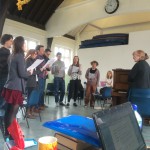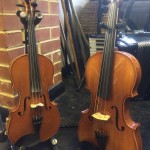Far From The Madding Crowd Rehearsal Blog – An interview with Catherine Jayes
13 April 2015
The final week of rehearsal upon Far From the Madding Crowd is now complete. I took the opportunity to ask our Composer and Musical Director Catherine Jayes a few questions about her compositions and the music within the production of Far From the Madding Crowd:
Where did you begin developing the ideas for the music within the production?
My initial source was of course Hardy’s novel to see what songs he had put into the book. There are 3 definite quoted songs as well as others mentioned and of those we have used one. Hardy was incredibly musical himself, like a lot of people from that era, a big part of their daily and social life, was music. Hardy was himself a fiddle player inheriting his musical talent from his father and grandfather who both played string instruments. He played all his life; I believe he was a really talented fiddle player. Fortunately, he wrote down many of his compositions, which we still have.
All of Hardy’s books have songs in; he writes about rural life and music was an integral part. When they had a harvest supper they didn’t have a DJ with people saying, ‘Can you turn that down?’ they provided their own entertainment. So a great many of the workers played some form of instrument, and indeed the character of Gabriel Oak within the story plays a pipe.
Our writer/Director Jessica Swale is also madly musical. I play something to her once and she can sing it back to me pretty much note for note; she has an extraordinary musical memory. Jess is very clear about what she likes and what she needs from the music, which is great as it gives you a definite guide as to where you are going with it.
There is a mix of original music and new composition within the production, so how did you begin to draw the musical
landscape for the production?
I immersed myself in the 19th Century folk world, traditional song and read a great many books. I am familiar with that world fairly well and have always loved it. I have loved that modal sound where the 7th’s are flattened and it goes from major to minor all the time. Apart from The Banks of Allan Water that is the song quoted in the book, I have chosen a couple of original songs. The style of these songs comes from Plainsong and songs of the high church, but not hymns. Again these songs were without sharps or flats, and without form, which is what folk music is, it goes away from the norm and surprises you and is very attractive because it is not always predictable.
These folk songs were handed down through the centuries. It was only with Cecil Sharp, Vaughan Williams and others who thought it was essential to start noting down what people where singing and passing down to their children. There was a real sense that the folk traditions were dying away along with the rural communities, and music hall and Parlour songs were becoming the popular form. But luckily there are also some very old recordings going back into the 19th Century of some old chap warbling into a machine and thank goodness! But as these traditional folk songs were passed down through the centuries, there would have been fashionable changes due to the times. And in a way, that is what I have done within this production; I have been very respectful of the period, although I’ve not completely reverent.
You have worked many times at The Watermill Theatre, only last year as musical director and arranger on the production of Calamity Jane, which is still enjoying a sell out tour of the UK. On this production you are working with actors who play instruments, rather than musicians who act. What challenges does this present as a MD and composer?
The first challenge is to get the music to the actors early. Musicians sit in orchestra pits for several years, never learning it, but these actors have to learn all the music and perform it within the piece. It’s a huge challenge for them and they never cease to amaze me. The practicalities of course are ‘who’s available?’ ‘he/she can’t play as she is up a ladder, in the middle of a scene, doing a scene change !’ etc.
The play is cast for the actor first and foremost, whilst conscientiously bearing in mind the need to play a musical instrument. Once they have been cast, I then get the call to say, ‘we’ve got a fiddle player, a trumpet, an accordionist.’ I might ask if we can find someone who plays a specific instrument but in many ways working within our world (of the creative arts) if you are given restrictions it can often be very freeing.
What are the instruments we will be hearing within this production?
Very much the instruments you would have heard within the period. Fiddles, pipes, accordion, drum, also guitar, {maybe not so typical in the 19th century rural communities}. Music within a piece can give it a feel-good element, it can also give a rest from the narrative; it is used to give a sense of change of venue, change of time. It is of course the hope that the music also becomes a valuable part of the story telling device, giving a sense of time, place and the emotion of the play.
On Saturday night it was the final performance of the sell-out Tuxedo Junction, and as soon as the ‘curtain’ fell the technical team began the ‘get out,’ taking the set down. 9am on Sunday morning the ‘get-in’ began putting the set for Far From the Madding Crowd in, ready for the company to move into the theatre today (Monday). As the Stage Management team moves the props over to the theatre, our Designer Philip Engleheart continues to make touches to his set, in preparation for the tech to begin. We will then open for our first preview on Thursday. It is going to be another busy, creative week at The Watermill Theatre.
Neil Bull
Assistant Director, Far From The Madding Crowd


